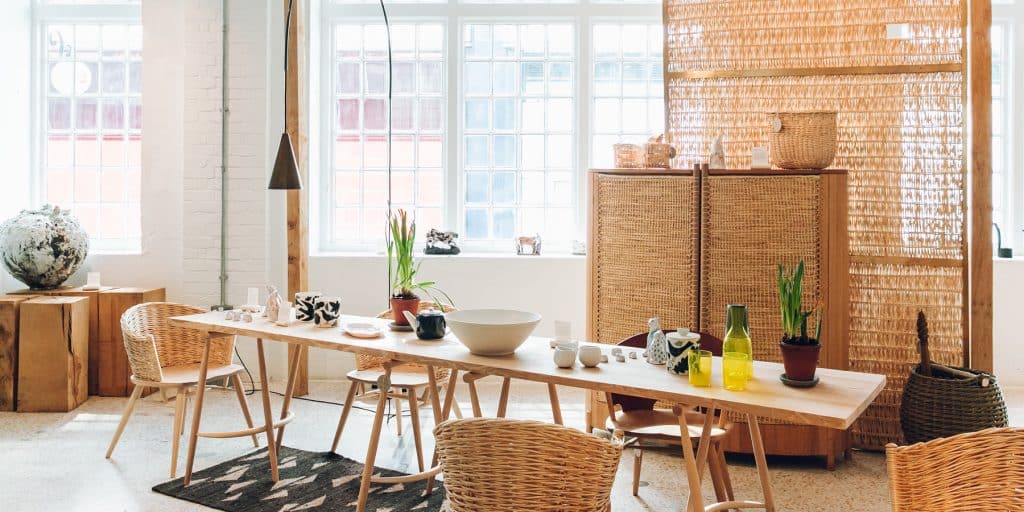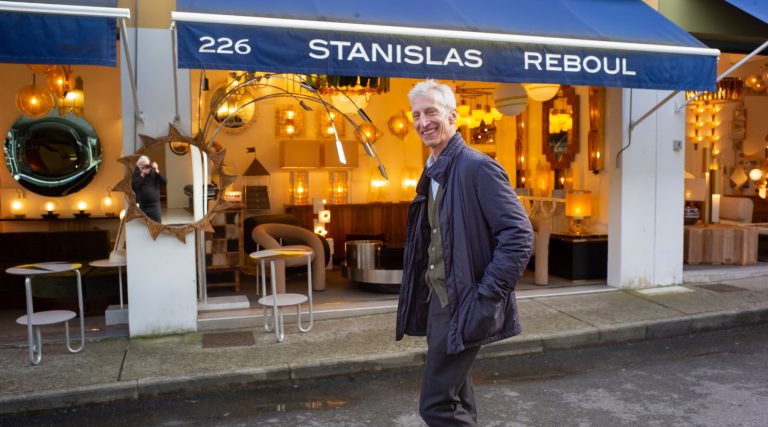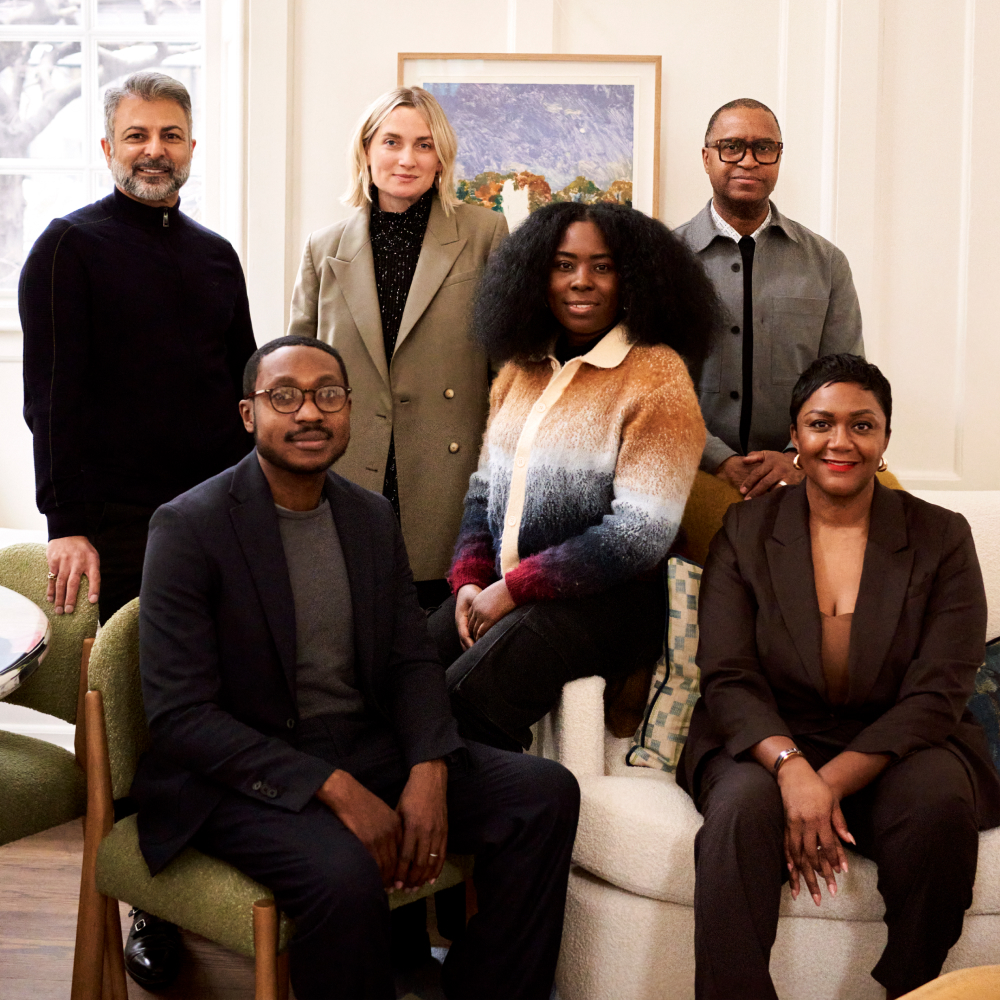
October 16, 2017Mark Henderson, Natalie Melton and Catherine Lock, founders of the New Craftsmen, are on a mission to advance British craft and design (portrait by James Merrell). Top: The New Craftsmen moved into its first permanent showroom in 2014 (all photos by Gareth Hacker, unless otherwise noted).
A satiny ash-wood cheeseboard. A mobile sculpture of steel, porcelain and glass. An antique linen napkin hand-stitched with a love poem. Wandering around the New Craftsmen store, an airy, peaceful space a stone’s throw from London’s busy Oxford Street, can turn into an exercise in self-restraint. The showroom is full of covetable, beautiful pieces of art, furniture, jewelry and more. And it holds just a fraction of the items curated by the New Craftsmen, the London-based organization with a shining reputation as the go-to source for the best of British craft and design.
“There are lots of art galleries, but there was nothing equivalent for makers,” says Catherine Lock, the creative director and one of the cofounders, with Natalie Melton and Mark Henderson, of the New Craftsmen. “Certainly nothing done in a way that was fresh, contemporary and relevant, with the right kind of energy.”
The organization came into being in 2012 through a lucky combination of encounters and shared interests, Lock says. She was trained as a fashion designer but had been working as a product developer, first for the furniture and lifestyle store Habitat and then at the supermarket chain Sainsbury’s. “I began to feel that the products I was developing were meaningless and disposable,” she explains. “It felt like the whole high street was homogenized, with no soul or individuality behind the items. In fact, even the luxury market felt homogenized.”
Her dissatisfaction coincided with a shift in the market, including in the supermarket trade. “People were starting to care about where things came from and spending a bit more on quality,” she says. “Even some of the big chains started to understand and embrace that.”

The founders stripped down their showroom space, maintaining its raw look to keep the focus on the works.

Sebastian Cox’s Scorched Shake sideboard is on display under a window in the showroom.
Offered a buyout from her job, she made a radical decision: She would rent out her apartment and travel around the United Kingdom looking for craft rooted in a local area and ethos. “I wanted to understand who was making the pieces and how they came into existence,” she explains. “It became very much a journey into my own culture and heritage.”
Several months later, Lock returned to London wanting to do something with the knowledge and material she had gathered. “It could have been a television program, a book or a shop — I didn’t really know,” she says. Shortly after she came back, she attended a talk on craft in Britain, chaired by Melton, at the Decorex trade fair. “When I told her what I’d been doing, her eyes widened,” Lock recalls. “She said, ‘I think you should meet Mark Henderson.’ ”
Melton, now the managing director of the New Craftsmen, had been running a mentoring program for makers in which Henderson, former chairman of Gieves & Hawkes, on Savile Row, and a veteran of the luxury market, had participated as mentor. Both were passionate about craft and began a conversation with Lock about developing a new kind of showcase for artisans. “We realized there was a gap for makers in the higher end of the market,” Lock says. “There were very few places that got behind craftspeople and promoted them.”
The trio wrote a business plan and raised some funding, then galvanized into action when Henderson was offered a pop-up shop on Carlos Place in London’s upmarket Mayfair neighborhood for the 2012 holiday season. “We put it together in six weeks,” Lock says. “The pop-up was behind the Connaught hotel, in a garage that had once been a carriage house. It had all the original features: cobbles, Victorian ceramic tiles, a manger for the horses. There was one tap, four plugs and no loo. But the makers are very imaginative, ingenious, resourceful people!”

The 2,000-square-foot showroom is in a former breeches factory in London’s North Mayfair neighborhood, just off Oxford Street.

Slipware plates by Douglas Fitch hang on a wall of the showroom next to a Maker’s trestle table by Lola Lely Studio. The ceramic pieces on the shelves in the foreground are by James and Tilla Waters.
The pop-up was a huge success, Lock says, in part because they hosted convivial breakfasts and dinners. These meals facilitated meetings among makers, designers and set the enthusiastic, warm tone that characterizes the organization to this day. (They continue to dine together, Lock says, noting, “We all like our food, and there are so many connections between the food world and the craft world.” During Frieze week in London, they cohosted two dinners with 1stdibs.)
After the pop-up, the partners were determined to find a permanent space. When the Grosvenor Estate (landlord of the Carlos Place property and of much of Mayfair) offered them a former breeches factory in North Mayfair, they seized the opportunity. They stripped the 2,000-square-foot property to its bare bones, opening for business in June 2014. “It’s a raw space, but we love it that way,” Lock says. “If it was too finished, we’d be the heroes, not the work.”
The work is always the hero at the New Craftsmen, which now represents around 120 creators of everything from beauty products to furniture. “We have never been a company that has aspired to a ‘look,’ ” Lock says. “It’s very eclectic, but I guess because it’s coming from just a few visions, it’s consistent too.” The difficult part, she adds, is finding makers who tick all the boxes for the New Craftsmen: elegance of form, great quality and attention to detail. There also has to be “some chemistry between us,” she adds. “It’s not just a business relationship.”

During this year’s London Design Festival, the New Craftsmen transformed the front of its showroom into a dining area featuring furniture from its new Common Parts collection. It also hosted a series of talks and workshops, making the space a hub for debate and discussion.

Clockwise from left: Akiko Hirai’s Moon jar, a cedar sculptural vessel by Nic Webb and a Pilotis side table by Malgorzata Bany.
Pedro da Costa Felgueiras, a paint and lacquer specialist, started working with the New Craftsmen around three years ago, after meeting Lock at the Hole & Corner magazine launch party, hosted by the New Craftsmen in its second pop-up shop, on Adams Row in Mayfair. “It has really raised my profile,” he says. “They believe in their makers and spend a lot of time publicizing them, and that has led to collaborations and projects I wouldn’t otherwise have had.” (These include his Courtesan bed, as well as a chair for Burberry, cocreated with furniture designer Sarah Kay.)
“As a craftsman, you have to have an audience to see your work, and you often don’t have that outlet,” says interior designer Kit Kemp, who, with her husband, Tim, owns the Firmdale Hotels group. “The New Craftsmen doesn’t just look for products. The first pieces I bought from them were fifty-seven baskets by makers from all over Britain. I thought it was so fascinating and clever to take something universal — weaving — and make it contemporary and relevant. It seemed like a shame to divide the collection, so we took it lock, stock and barrel.” (The baskets now hang over the bar at the Whitby Hotel, the hospitality group’s newest property, on New York’s West 56th Street.)
The New Craftsmen’s latest creative project is its most ambitious to date: a collection of furniture, called Common Parts, designed by Sue Skeen and crafted by a variety of makers. The line grew out of a request from Burberry fashion house to transform the café at its flagship Regent Street store. “Sue and I kept thinking how wonderful it would be to put in our own furniture,” Lock explains. “There was a back-of-the-taxi conversation, and we decided there was great potential to appeal to our clients.”

The warming cabinet is a collaboration between furniture designer Gareth Neal, who created the oak structure, and chair maker Kevin Gauld, who wove the straw doors using traditional methods. On top of the cabinet is a portrait by Holly Freen and ceramic vessels by Iva Polachova.
The collection is limited, with two benches, two tables and a seat, all of which can be customized with different colors, tops, woods and other materials. “We want our pieces to be enhanced by people’s own furniture,” Lock explains. “They will go with everything, ancient or modern.”
The ethos of the New Craftsmen is not to grow constantly but to work with makers in the most committed way and to remain attuned to beauty and quality, Lock says. (For the moment, the partners also remain dedicated to representing only British craft.)
“I love finding makers who are innovating and pushing boundaries and finding their unique identity within their particular materiality and discipline,” Lock says. “And as we’ve grown, working with interior designers and responding to requests online, we understand more about what people would like. Ultimately, we would like to fill everyone’s life with craft.”
Visit The New Craftsmen on 1stdibs








